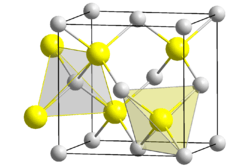Beryllium sulfide
 | |
| Identifiers | |
|---|---|
3D model (JSmol) |
|
| ChemSpider | |
| ECHA InfoCard | 100.033.680 |
| EC Number | 237-064-6 |
PubChem CID |
|
| |
| |
| Properties | |
| BeS | |
| Molar mass | 41.077 g/mol |
| Appearance | white crystalline |
| Density | 2.36 g/cm3 |
| Melting point | 1,800 °C (3,270 °F; 2,070 K) decomposes |
| Band gap | 7.4 eV |
Refractive index (nD) |
1.741 |
| Structure | |
| cubic | |
| Thermochemistry | |
Heat capacity (C) |
34 J/mol K |
Std molar entropy (S |
34 J/mol K |
Std enthalpy of formation (ΔfH |
-235 kJ/mol |
| Hazards | |
| US health exposure limits (NIOSH): | |
PEL (Permissible) |
TWA 0.002 mg/m3 C 0.005 mg/m3 (30 minutes), with a maximum peak of 0.025 mg/m3 (as Be)[1] |
REL (Recommended) |
Ca C 0.0005 mg/m3 (as Be)[1] |
IDLH (Immediate danger) |
Ca [4 mg/m3 (as Be)][1] |
Except where otherwise noted, data are given for materials in their standard state (at 25 °C [77 °F], 100 kPa). | |
| Infobox references | |
Beryllium sulfide (BeS) is an ionic compound from the sulfide group [2] with the formula BeS.
Preparation
Beryllium sulfide powders can be prepared by the reaction of sulfur and beryllium in a hydrogen atmosphere by heating the mixture for 10-20 minutes at temperatures from 1000-1300 °C.
Alternatively, it can be prepared by the reaction of beryllium chloride and hydrogen sulfide at 1150 °C, though this reaction will leave chlorine impurities.
References
- 1 2 3 "NIOSH Pocket Guide to Chemical Hazards #0054". National Institute for Occupational Safety and Health (NIOSH).
- ↑ Kenneth A. Walsh (2009). Beryllium Chemistry and Processing. ASM International. p. 127. ISBN 087170721-7.
This article is issued from
Wikipedia.
The text is licensed under Creative Commons - Attribution - Sharealike.
Additional terms may apply for the media files.